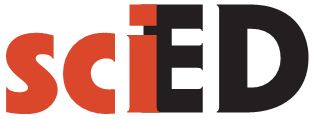Abstract
Traditionally, comics are perceived as a specific popular medium. Thanks to their popularity and understandability for adolescents, they are nowadays paid increasing attention even in the domain of science education. In this respect, an important aspect of the comics is their content as well as their means of expression. This study aims to explore the educational potential of the medium and to suggest ways of its beneficial educational use for the contemporary NET-generation of students. Based on the selected examples, educational comics are analyzed as means supporting the transformation of scientific educational concepts to a more understandable form. First, the reader is familiarized with the benefits of comics with respect to the educational needs of the current generation of students. Further, the qualities and functioning of comics as educational means are explained.Finally, recommendations for the effective use of comics in science instruction are
suggested.
References
Aldama, F. L. (2012). Comics. In S. Bost & F. R. Aparicio (Eds.), The Routledge Companion to Latino/a Literature (361–374). London: Routledge.
Bennett, S., Maton, K., & Kervin, L. (2008). The ‘digital natives’ debate: A critical review of the evidence". British Journal of Educational Technology, 39(5), 775–786
Cohen, T. (2013). Humor. In B. Gaut & D. McIver Lopez. The Routledge Companion to Aesthetics (425–431). London: Routledge.
Downes, S. (2005, December 12). An introduction to connective knowledge. Retrieved on November 12, 2006, from http://www.downes.ca/cgi-bin/page.cgi?post=33034.
Fry, A., Wilson, J., & Overby, C. (2013). Teaching the design of narrative visualization for financial literacy. Art, Design & Communication in Higher Education, 12(2), 159–177.
Gruenberg, S. M. (1944). The Comics as a Social Force. Journal of Educational Sociology, 18(4), s. 204–213.
Grunwald, P. (2003). Key Technology Trends: Excerpts from New survey research sundings, exploring the digital generation, Educational Technology. Washington: Department of Education.
Hempelmann, F., Samson, A. C. (2008). Cartoons: Drawn jokes? In V. Raskin (Ed.), The primer of humor research (609–640). Berlin: Walter de Gruyer.
Kop, R. & Hill, A. (2008). Conectivism: Learning theory of the future or vestige of the past? International Review of Research in Open and Distance Learning, 9(3), 1–13.
Mayer, R. E. (2011). Instruction based on visualizations. In Mayer, R. E. & Alexander, P. A. (Eds.), Handbook of Research on Learning and Instruction (427–445). New York: Routledge.
McLoud, S. (1993). Understanding Comics. Northamption: Kitchen Sink Press.
Meskin, A. (2013). Comics. In B. Gaut & D. M. Lopes (Eds.), The Routledge companion to aesthetics (575–584). London: Routledge.
Munier, G. (2000). Geschichte im Comics: Aufklärung durch Fiktion? Hannover: Unser Verlag.
Oblinger, D. & Oblinger, J. (2005). Educating the Net Generation. EDUCAUSE. Dostupné na: http://www.educause.edu/educatingthenetgen/
Peltz, A. (2013). A visual turn: Comics and art after the graphic novel. Art in Print, 2(6), 8–14.
Siemens, G. (2004). Connectivism: A learning theory for the digital age. International Journal of Instructional Technology and Distance Learning. Retrieved on November 12, 2006, from http://www.itdl.org/Journal/Jan_05/article01.htm.
Short, J. C., & Reeves, T. C. (2009). The graphic novel: A cool format for communicating to generation Y. Business Communication Quarterly, 72(4), 414–430.
Šeďová, K. (2013). Humor ve škole. Brno: MUNI Press.
Tensuan, T. (2014). Comics. In R. C. Lee (Ed.), The Routledge companion to Asian American and Pacific islander literature (415–425). London: Routledge.
Trnová, E. (2012). Komiksy ve výuce chemie. Media4u Magazine, 9(X4), 119–123.
Trnová, Eva, Trna, J. & Vacek, V. (2013). The Roles of Cartoons and Comics in Science Education. In M. Costa, B. Dorio, M. Kireš. HSci2013. Educating for Science and through Science (240 -244). Košice: P. J. Šafarik University.
Vacek, V., Janko, T. (2014). Možnosti komiksu jako didaktického prostředku: inspirace pro přírodovědnou výuku. Komenský, 138(4), 40–46.
Varnum, R. & Gibbons, Ch. T. (2001). The Language of Comics: Word and Image. Jackson: University Press of Mississippi.
Versaci, R. (2001). How comic books can change the way our students see literature: One teacher's perspective. English Journal, 91(2), 61–67.
Williams, R. M. C. (2008). Image, text, and story: Comics and graphic novels in the classroom. Art Education, 61(6), 13–19.
Wimms, A. S. & Berge, Z. L. (2009). Comics: they´re not just for kids anymore. Chief Learning Officer, Dostupné na: http://www.clomedia.com/articles/comics_they_re_not_
just_for_kids_anymore.
Wolf, S., Coats, K., Enciso, P., & C. Jenkins (Eds). (2010). The handbook of research on children's and young adult literature. New York: Routledge.
Authors who publish with this journal agree to the following terms:
- Authors retain copyright and grant the journal right of first publication with the work simultaneously licensed under a Creative Commons Attribution License that allows others to share the work with an acknowledgement of the work's authorship and initial publication in this journal.
- Authors are able to enter into separate, additional contractual arrangements for the non-exclusive distribution of the journal's published version of the work (e.g., post it to an institutional repository or publish it in a book), with an acknowledgement of its initial publication in this journal.
- Authors are permitted and encouraged to post their work online (e.g., in institutional repositories or on their website) prior to and during the submission process, as it can lead to productive exchanges, as well as earlier and greater citation of the published work (See The Effect of Open Access).
